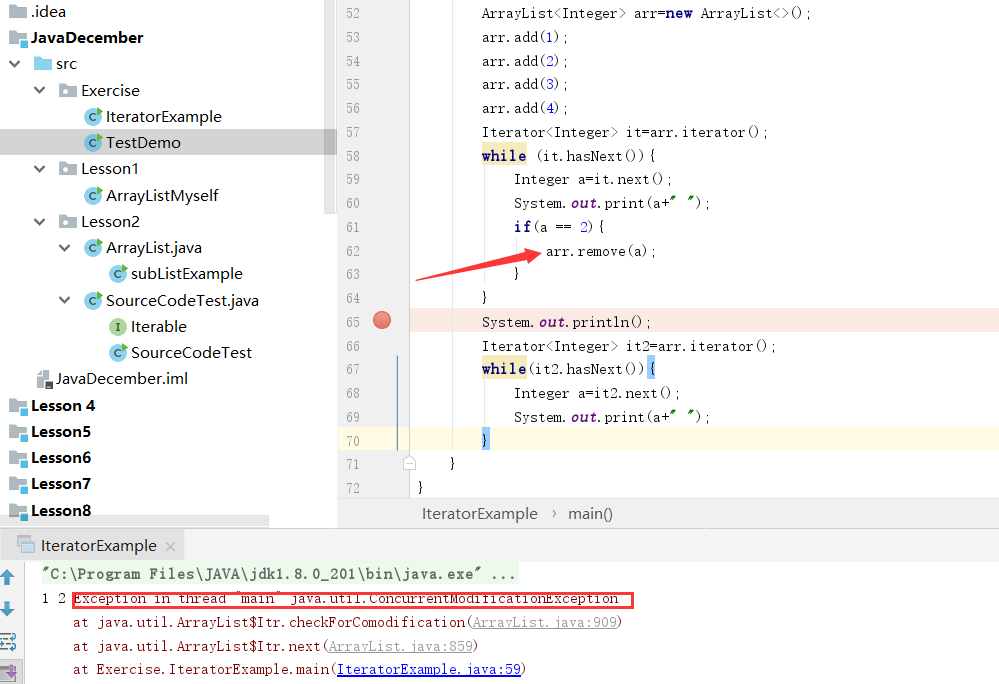集合的继承关系:

Iterator迭代器是一个接口,无法直接使用,需要使用Iterator接口的实现类对象,获取该类的方法比较特殊
遍历集合元素的两种方式:Iterator迭代器 增强for循环(foreach)一般的for循环(get(i)获取每一个元素)
一:迭代器实现集合的遍历:
package Exercise; import java.util.ArrayList; import java.util.Collection; import java.util.Iterator; /** * 2020/1/7 * java.util.Iterator接口:迭代器(对集合元素进行遍历) * E next 取出集合中的下一个元素 * boolean hasNext()判断集合中还有没有下一个元素 * Iterator迭代器是一个接口,无法直接使用,需要使用Iterator接口的实现类对象,获取该类的方法比较特殊 * Collection接口中有一个方法叫iterator(),返回的就是迭代器的实现类对象Iterator<E> iterator * * 迭代器的使用步骤: * 1.使用集合中的方法iterator()获取迭代器的实现类对象,使用iterator接口接收(多态) * 2.hasNext()方法判断 * 3.next()方法取出集合中的下一个元素 */ public class IteratorExample { public static void main(String[] args) { Collection<String> col=new ArrayList<>(); col.add("zhang"); col.add("zhao"); col.add("wang"); col.add("li"); col.add("hui"); //多态的具体应用:基类引用,引用不同的派生类对象 public interface Collection<E> extends Iterable<E> // 1.使用集合中的方法iterator()获取迭代器的实现类对象,使用iterator接口接收(多态) //接口 实现类对象 Iterator<String> iter = col.iterator(); // boolean b=iter.hasNext(); // System.out.println(b); // String s=iter.next(); // System.out.println(s);//zhang //2.hasNext()方法判断 //3.next()方法取出集合中的下一个元素 while(iter.hasNext()){ System.out.println(iter.next()); } } }
zhang
zhao
wang
li
hui
具体函数分析:

不能写成这样,会报java.util.NoSuchElementException的异常

二:foreach循环(增强for循环)遍历集合数组:
Collection<String> col=new ArrayList<>(); col.add("zhang"); col.add("zhao"); col.add("wang"); col.add("li"); col.add("hui"); for(String s:col){ //s相当于下标 System.out.println(s);}
用增强for循环遍历普通数组:
public static void testFor(){ String[] str=new String[]{"aa","bb","dd"}; for(String s:str){ System.out.print(s+" "); } }

注: forEach循环的面试题,查看输出结果:
public static void testFor(){ String[] str=new String[]{"aa","bb","dd"}; for(String s:str){ System.out.print(s+" ");//aa bb dd } System.out.println(); } public static void testFor2(){ String[] str=new String[]{"aa","bb","dd"}; for(int i=0;i<str.length;i++){ str[i]=i+" ";//真正修改数组的值 } System.out.println(Arrays.toString(str));//0 1 2 } public static void testFor3(){ String[] str=new String[]{"aa","bb","dd"}; for(String s:str){ s="AA"; //此处s是临时变量 System.out.print(s+" ");//"AA AA AA"" } System.out.println(); System.out.println(Arrays.toString(str));//aa bb dd }

三:用迭代器删除元素:
ArrayList<Integer> arr=new ArrayList<>();
arr.add(1);
arr.add(2);
arr.add(3);
arr.add(4);
Iterator<Integer> it=arr.iterator();
while (it.hasNext()){
int a=it.next();
System.out.print(a+" ");
if(a==2){
it.remove();
}
}
Iterator<Integer> it2=arr.iterator();
while(it2.hasNext()){
System.out.print(it2.next()+" ");
}

如果用ArrayList增加数据:
ArrayList<Integer> arr=new ArrayList<>(); arr.add(1); arr.add(2); arr.add(3); Iterator<Integer> it=arr.iterator(); while (it.hasNext()){ Integer a=it.next(); System.out.print(a+" "); if(a==2){ arr.add(7); } } System.out.println(); Iterator<Integer> it2=arr.iterator(); while(it2.hasNext()){ System.out.print(it2.next()+" "); }
Exception in thread "main" java.util.ConcurrentModificationException
用ArrayList删除:
ArrayList<Integer> arr=new ArrayList<>(); arr.add(1); arr.add(2); arr.add(3); arr.add(4); Iterator<Integer> it=arr.iterator(); while (it.hasNext()){ Integer a=it.next(); System.out.print(a+" "); if(a == 2){ arr.remove(a); } } System.out.println(); Iterator<Integer> it2=arr.iterator(); while(it2.hasNext()){ Integer a=it2.next(); System.out.print(a+" "); }
Exception in thread "main" java.util.ConcurrentModificationException

注:如果要删除,不能删除的是倒数第二个元素;如果调用ArrayList对象的remove(),刚好删除的倒数第二个元素,那么因为找不到下一个元素,所以不会报出异常